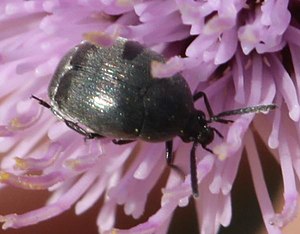Spermophagus sericeus
| Spermophagus sericeus | ||||||||||||
|---|---|---|---|---|---|---|---|---|---|---|---|---|

Spermophagus cf. sericeus on a thistle |
||||||||||||
| Systematics | ||||||||||||
|
||||||||||||
| Scientific name | ||||||||||||
| Spermophagus sericeus | ||||||||||||
| ( Geoffroy , 1785) |
Spermophagus sericeus , also known as the rockrose seed beetle , is a beetle from the subfamily of the seed beetles (Bruchinae).
features
The 1.5–2.9 mm long beetles have a short oval shape. The black beetles have silver-gray hairs. The pronotum is double-dotted. On the middle of the pronotum, the coarser puncture often almost disappears. Several fine rows of dots run over the wing covers . The wing covers do not cover the entire abdomen . The antennae and legs are black.
Similar species
- Bruchidius ater - no long spines in front of the end of the tibia (splints)
- Spermophagus calystegiae - pronotum punctured evenly over the entire surface; the points of the stripes of the elytra are usually less fine than in the spermophagus sericeus ; essentially only distinguishable by genital examination; Immigrated to Central Europe from Eastern Europe in recent years.
- Spermophagus kuesteri - the thorns on the posterior tibia are red; common in southern Europe
Occurrence
The beetle species is widespread and common in southern and central Europe. In the north, their occurrence extends to the south of Fennoscandinavia . The species occurs locally in England. The species is absent in the mountains.
Way of life
As host plants of the beetle species that apply bindweed convolvulus arvensis ( Convolvulus arvensis ), Real bindweed ( Calystegia sepium ) and beach morning glory ( Calystegia soldanella ). The females lay their eggs on the surface of the seeds from the beginning of June. The newly hatched larvae dig into the seeds from mid-June, where they finally pupate . In Europe, Spermophagus sericeus is the only species of the genus that develops in seeds of the bindweed.
The adult beetles fly from May to September. They are most commonly seen between mid-May and late June. The beetles visit the flowers of various plants, especially the bindweed family, daisy family (thistles, thistles, cornflowers) and rose plants.
Natural enemies
As Eiparasitoide of Spermophagus sericeus apply chalcids Uscana spermophagi from the family Trichogrammatidae , Bruchophagus sp. from the family Eurytomidae and Dinarmus acutus from the family Pteromalidae .
Taxonomy
The following synonyms can be found in the literature :
- Euspermophagus sericeus ( Geoffroy , 1785)
- Bruchus sericeus Geoffroy , 1785
- Mylabris sericeus Geoffroy , 1785
- Spermophagus subdenudatus Motschulsky , 18747
- Euspermophagus cisti auct., Nec Olivier
- Euspermophagus cardui Boheman
Web links
- Spermophagus sericeus at www.kaefer-der-welt.de
- www.kerbtier.de
Individual evidence
- ↑ a b c d e f Jiři Zahradnik, Irmgard Jung, Dieter Jung et al .: Beetles of Central and Northwestern Europe: an identification book for biologists and nature lovers . Parey, Berlin 1985, ISBN 3-490-27118-1 , pp. 273 .
- ↑ a b c d e f European beetles - Spermophagus sericeus . www.coleo-net.de. Retrieved August 18, 2018.
- ↑ a b c d e f Heinz Freude , Karl Wilhelm Harde , Gustav Adolf Lohse (ed.): Die Käfer Mitteleuropas . tape 10 : Bruchidae – Curculionidae 1 . Goecke & Evers , Krefeld 1981, ISBN 3-87263-029-6 , pp. 14 .
- ↑ a b c Karel Hůrka: Brouci České a Slovenské Republiky / Beetles of the Czech and Slovak Republics . Kabourek, Zlin 2005, ISBN 80-86447-11-1 , p. 240 (German, Czech).
- ↑ Spermophagus sericeus in Fauna Europaea
- ^ Karl Wilhelm Harde , František Severa : Der Kosmos-Käferführer. The Central European beetle . Franckh-Kosmos, Stuttgart 2000, ISBN 3-440-06959-1 , p. 300 .
- ↑ a b c d e f Peter Toth, Monika Tothova, Ľudovít Cagáň: Bionomics of Spermophagus sericeus (Geoffroy) (Coleoptera: Bruchidae) - A potential biological control agent fo convolvulus arvensis L. (PDF, 216 KB) Acta fytotechnica et zootechnica, Vol. 4, 2001, Proceedings of the International Scientific Conference on the Occasion of the 55th Anniversary of the Slovak Agricultural, University in Nitra. Retrieved August 18, 2018.
